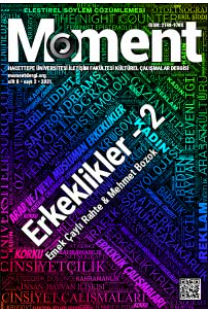UZUN SÜRELİ ETNOGRAFİNİN ÖNEMİ ÜZERİNE VE POSTILL'E BİR YANIT
ON THE VALUE OF LONGITUDINAL MEDIA ETHNOGRAPHY AND A RESPONSE TO POSTILL
___
- Abu-Lughod, L. (2016). Veiled Sentiments Honor and Poetry in a Bedouin Society (30th Anniversary Edition ed.). Berkeley: University of California Press.
- Algan, E. (2013). Youth, New Media, and Radio: Mobile Phone and Local Radio Convergence in Turkey. In M. Hilmes & J. Loviglio (eds.), Radio's New Wave: Global Sound in the Digital Era (pp. 79-90). New York: Routledge.
- Burawoy, M. (2003). Revisits: An Outline of a Theory of Reflexive Ethnography. American Sociological Review, 68(5), 645-679.
- Kottak, C. P. (2012). Prime-Time Society: An Anthropological Analysis of Television and Culture (Updated edition ed.). New York and London: Routledge.
- La Pastina, A. C., Straubhaar, J., & Sifuentes, L. (2014). Why Do I Feel I Don't Belong to the Brazil on TV? Popular Communication: The International Journal of Media and Culture, 12(2), 104-116.
- O'Connor, H., & Goodwin, J. (2012). Revisiting Norbert Elias's sociology of community: learning from the Leicester re-studies. The Sociological Review, 60(3), 476-497.
- O'Reilly, K. (2012). Ethnographic returning, qualitative longitudinal research and the reflexive analysis of social practice. The Sociological Review, 60(3), 518-536.
- Pace, R. &. (2013). Amazon Town TV: An Audience Ethnography in Gurupá, Brazil. Austin: University of Texas Press.
- Peacock, J. (1968). Rites of modernization: social and symbolic aspects of Indonesian proletarian drama . Chicago: University of Chicago Press.
- Peterson, M. A. (2009). Response to John Postill. Social Anthropology, 17(3), 337-340.
- Philipson, C. (2012). Community studies and re-studies in the 21st century: methodological challenges and strategies for the future. The Sociological Review, 60(3), 537-549.
- Tucker, H. (2010). Peasant-entrepreneurs: A Longitudinal Ethnography. Annals of Tourism Research, 37(4), 927-946.
- ISSN: 2148-970X
- Yayın Aralığı: 2
- Başlangıç: 2014
- Yayıncı: Hacettepe Üniversitesi İletişim Fakültesi
Sosyal Antropolojide Yöntem ve Etik Sorunu: "Klasik Etnografiden Diyalojik Etnografiye Doğru"
UZUN SÜRELİ ETNOGRAFİNİN ÖNEMİ ÜZERİNE VE POSTILL'E BİR YANIT
ZAMANIN İZİNDE KENTİ DENEYİMLEMEK: KENT VE BELLEK ÜZERİNE OTO-ETNOGRAFİK BAKIŞLAR
Çağdaş CEYHAN, ZÜLEYHA ÖZBAŞ ANBARLI, NALAN OVA
Z. Nilüfer Nahya, Rabia HARMANŞAH
ON ANTHROPOLOGY, EDUCATION AND UNIVERSITY: AN INTERVIEW WITH TIM INGOLD
ÇOKLU TÜRLER ETNOGRAFİSİ: YÜZ YÜZE BİR ARAŞTIRMA İMKÂNI ÜZERİNE DÜŞÜNCELER
